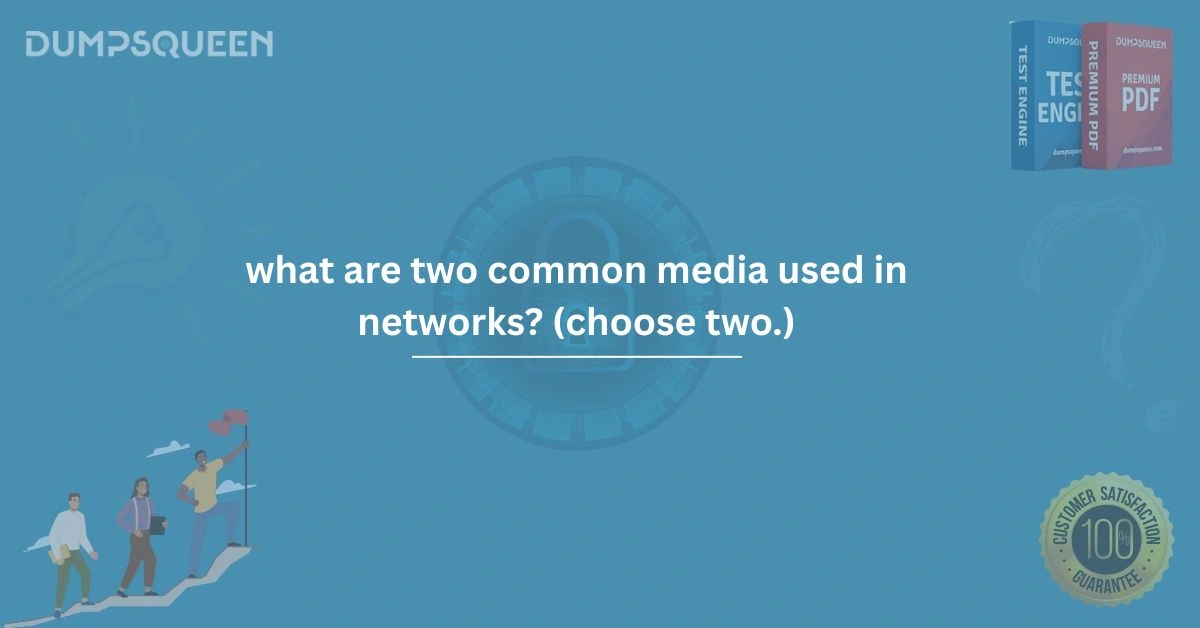Introduction
In the modern world of networking, the choice of media used to connect devices is paramount to ensuring the efficient transmission of data. With multiple types of networking media available, it’s essential to understand the various options to make the best selection for different environments and requirements. This article explores two common types of network media, explaining their functionalities, characteristics, and how they are applied in real-world networking scenarios. As a part of DumpsQueen’s comprehensive networking study resources, this blog provides valuable insights, offering information crucial for students preparing for certifications and professionals looking to strengthen their understanding of network architecture.
What Are Network Media?
Network media refers to the physical or logical pathways that enable data to travel across a network. These media can be physical or wireless and are used to connect different network components like computers, servers, switches, routers, and other devices. The media chosen for a particular network depends on factors such as distance, data transfer rate, cost, and environmental considerations. In this article, we will focus on two of the most common network media: Copper Cables and Fiber-Optic Cables. Each of these media plays an essential role in network infrastructure, helping determine the performance, scalability, and reliability of a network. Let’s take a deep dive into these two primary types of network media to better understand their properties and applications.
Copper Cables: The Backbone of Traditional Networking
Copper cables, especially twisted-pair cables and coaxial cables, have been the cornerstone of network media for decades. These cables are still widely used in various network setups, particularly in local area networks (LANs). Copper cables transmit data using electrical signals.
Types of Copper Cables
There are several types of copper cables used in networking, with Twisted Pair Cables and Coaxial Cables being the most common. Let’s explore each type in more detail.
Twisted-Pair Cables:
Twisted-pair cables consist of pairs of insulated copper wires twisted together. This design helps reduce interference from external electrical sources. These cables are widely used for Ethernet connections in LANs, as well as in telephone lines. Twisted-pair cables come in two categories:
Unshielded Twisted Pair (UTP): UTP is commonly used in residential and commercial settings due to its cost-effectiveness. It does not have additional shielding around the wires, making it susceptible to electromagnetic interference (EMI).
Shielded Twisted Pair (STP): STP has additional shielding that helps reduce EMI and provides better performance over longer distances. This makes STP more suitable for environments with high interference.
Coaxial Cables:
Coaxial cables consist of a central conductor (usually copper), insulation, a metallic shield, and an outer cover. These cables offer greater resistance to interference than twisted-pair cables and were traditionally used for cable television and early Ethernet networks. Coaxial cables are still used in some network configurations but are increasingly being replaced by faster, more efficient alternatives such as fiber optics.
Advantages of Copper Cables
Cost-effective: Copper cables are relatively inexpensive compared to other types of media. Easy to install and maintain: With an established track record in networking, copper cables are easy to set up and troubleshoot. Widely available: Copper cables are available almost everywhere, making them easy to source and replace.
Limitations of Copper Cables
Signal degradation over long distances: The electrical signals degrade as they travel longer distances, which limits the range of copper cables. Susceptible to electromagnetic interference (EMI): Copper cables, especially UTP cables, are sensitive to interference from nearby electrical equipment. Lower bandwidth capacity: Copper cables generally support lower data transfer speeds compared to fiber-optic cables.
Fiber-Optic Cables: The Future of High-Speed Networking
Fiber-optic cables are another crucial type of networking media that have revolutionized the speed and efficiency of data transmission. Unlike copper cables, which use electrical signals, fiber-optic cables transmit data using light signals. These cables are designed with an internal core made of glass or plastic that carries the light signal, which is then reflected within the core through a process called total internal reflection.
Types of Fiber-Optic Cables
Fiber-optic cables can be categorized based on the number of fibers and the material used for the core. The two main types are:
Single-Mode Fiber (SMF):
Single-mode fiber has a small core that allows only one mode of light to pass through at a time. This results in less signal attenuation and allows data to travel over much greater distances often up to 100 kilometers or more without any significant loss of signal quality. SMF is typically used in long-distance and high-speed communication networks, such as telecommunications networks.
Multi-Mode Fiber (MMF):
Multi-mode fiber has a larger core that allows multiple modes of light to travel simultaneously. While MMF has a lower bandwidth capacity and signal range than SMF, it is more cost-effective and often used for shorter distances, such as within data centers or campus networks.
Advantages of Fiber-Optic Cables
High bandwidth capacity: Fiber-optic cables provide significantly higher data transfer rates than copper cables, often exceeding 100 Gbps.Long-distance transmission: Fiber-optic cables can transmit data over long distances (many kilometers) without signal degradation.Immunity to electromagnetic interference (EMI): Unlike copper cables, fiber-optic cables are not affected by electromagnetic interference, making them ideal for high-precision and mission-critical applications.Enhanced security: It is difficult to tap into fiber-optic cables, providing better security for data transmission.
Limitations of Fiber-Optic Cables
Higher cost: Fiber-optic cables and the associated hardware tend to be more expensive than copper cables, especially for initial installation.Fragility: Fiber-optic cables are more fragile than copper cables and can be damaged more easily, requiring careful handling during installation.Complex installation: Fiber-optic networks require specialized equipment and skills to install and maintain.
Comparing Copper Cables and Fiber-Optic Cables
To understand which of these media is most appropriate for a particular network, it’s important to compare their capabilities. Below is a comparison between copper cables and fiber-optic cables based on several key factors.
| Factor | Copper Cables | Fiber-Optic Cables | |
|---|---|---|---|
| Cost | Lower cost | Higher cost | |
| Bandwidth Capacity | Lower (up to 10 Gbps) | Higher (up to 100 Gbps or more) | |
| Distance | Limited (100m - 500m) | Very long distance (10 km or more) | |
| Interference | Susceptible to EMI | Immune to EMI | |
| Installation Ease | Easy to install and maintain | More complex installation |
Applications of Copper and Fiber-Optic Cables in Networking
Both copper and fiber-optic cables are used in various types of networking setups. However, their applications differ depending on the specific needs of the network. Let’s take a closer look at where each type of media is used.
Applications of Copper Cables
-
Local Area Networks (LANs): Copper cables, particularly twisted-pair cables, are widely used in LANs to connect computers, printers, and other devices in offices or homes.
-
Ethernet Connections: Copper cables are commonly used for Ethernet connections, supporting speeds up to 1 Gbps or 10 Gbps over short distances.
-
Telephone Systems: Twisted-pair cables are used for traditional telephone lines and communication networks.
Applications of Fiber-Optic Cables
-
Long-Distance Communication: Fiber-optic cables are ideal for long-distance communication, such as between cities or across countries, due to their high bandwidth and low signal attenuation.
-
Data Centers: Fiber-optic cables are widely used in data centers to provide high-speed connections between servers and switches.
-
High-Speed Internet: Fiber-optic cables are used by internet service providers (ISPs) to deliver ultra-fast internet connections to businesses and homes.
Free Sample Questions
Which of the following is a characteristic of fiber-optic cables?
A) Susceptible to electromagnetic interference (EMI)
B) Low bandwidth capacity
C) Uses light signals to transmit data
D) Limited to short-distance transmissions
Answer: C) Uses light signals to transmit data
What is the main advantage of using copper cables in networking?
A) Higher cost
B) Higher bandwidth capacity
C) Easy installation and availability
D) Immunity to electromagnetic interference
Answer: C) Easy installation and availability
Which type of fiber-optic cable is ideal for long-distance communication?
A) Single-Mode Fiber (SMF)
B) Multi-Mode Fiber (MMF)
C) Twisted-Pair Copper Cables
D) Coaxial Cables
Answer: A) Single-Mode Fiber (SMF)
Conclusion
Understanding the different types of network media is critical for anyone involved in network design or maintenance. Copper cables and fiber-optic cables, while both essential in the realm of networking, each have distinct advantages and limitations. Copper cables offer an affordable and widely accessible solution for short-distance networking, while fiber-optic cables provide exceptional speed, security, and distance capabilities, making them ideal for modern, high-performance networks. Whether you’re preparing for certification exams, setting up a new network, or troubleshooting an existing one, understanding how these media work and their respective applications is a vital part of your networking knowledge. As part of the DumpsQueen community, we are committed to helping you succeed by providing valuable study materials and insights to enhance your learning experience.




